
For the past three years I have been actively attempting to climb it and ever since I purchased Bill Birkett's Classic Climbs of Great Britain at the tender age of nineteen I've been thinking about it. My efforts have taken the shape of an annual pilgrimage to the Lochinver area around the months of May and June for a week.
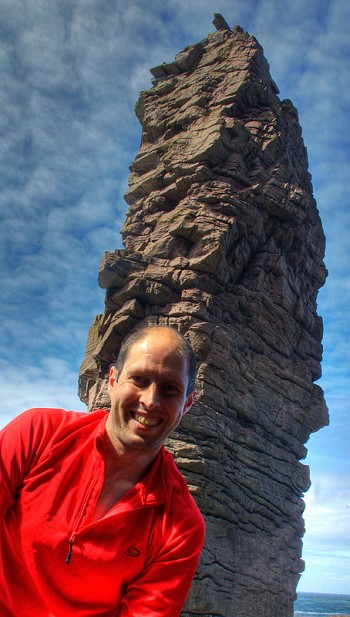
After reading his award winning book Psychovertical I realised that a partner may not be required to complete the climb, if I was willing to accept a riskier approach. Wren Industries' Silent Partner allows you to use a rope for protection while leading free climbs alone. Had this item not been so strongly recommended I would have dismissed it, as the price was near two hundred pounds once I'd imported it from the United States. I was to have further wallet ache when I saw another one go for seventy pounds on ebay the following week.
My previous efforts at roped soloing in the dim and distant past using a modified Petzl Gri-Gri, were found to be too cumbersome to make it a reasonable proposition. The SP roughly comprises of a clutch spindle surrounded by a sheet metal housing. This operates in a very similar way to the inerter seatbelts found in most modern cars. A loose clove hitch tied around the spindle tightens and the device locks when a shock is applied to it. The SP requires ground anchors and the climber to carry the entire length of rope in several loops from their harness as well as the considerably sized SP. With that merry lot dangling between my legs I had the gait of John Wayne. However this did not put me off, but for fear of ridicule I was compelled to hide my guilty secret by climbing very early in the morning at less frequented crags.
After making several test jumps onto the gear I was happy that the SP was up to the job and set about repeating a few Anglezarke classic VS's that had decent ground anchors (Birthday Crack, Samarkand and Sunbeam). I had realised that the Old Man had good ground anchor potential on its south side at least, after previous visits. I made the decision much earlier to attempt an ascent via the south end to avoid the needless original traverse, which according to various sources was often wet. It also didn't lend itself to my new approach, requiring more rope, gear and time to reach the same destination, the summit. I had also seen the BBC television programme featuring Tim Emmett and Julia Bradbury using this approach, which seemed to make the most sense for the easiest way to the top.
On reading the SMC's Northern Highlands North guidebook description to the original route on the Old Man, I was lead to believe that the climb could be completed in two long pitches. This plus the fact that the SP does not require running belays meant the possibility of climbing the stack in a single pitch started to enter my consciousness. If this were possible it could speed up the ascent leaving valuable time for unforeseen circumstances. All I needed now was a seventy metre lead rope, but thanks to the advent of sport climbing this would not be a problem and the necessary purchase was made.
A plan was now starting to form with which I could in theory reach the summit, but how would I return to the ground and retrieve the lead rope plus all the gear. The answer to this was to arrive via Long and Middendorf's Big Walls text. According to this I could trail an abseil rope behind me while I climbed, pooling it at the end of every traditional pitch or handily sized ledge to reduce the possibility of snagging. Upon reaching the summit I would anchor one end and then drop the rest, allowing me to abseil back to my start point. As well as this concept I could also retrieve my lead rope and gear by jumarring, collecting the protection and rope along the way. However, due to the possibility of abrasion and my unwillingness to cover the mighty monolith in duck tape I thought that a better approach would be to simply free climb to the top for a second time, allowing the in-situ lead rope to protect me from above while I progressed up it using a Petzl Shunt to minimise fall potential.
On Wednesday 22nd June my father and I made the long journey to the delightful Achmelvich campsite just outside the village of Lochinver, which was to be our base for the next week. Although we were able to pitch the tent in the dry, the continuing changeable conditions did not bode well for success. After several showers during the night we opted for an ascent of Stac Pollaidh the following day hoping for better weather in the coming days. By midday all the showers had died out and we were stood on the summit in reasonable sunshine and it was difficult to understand when or where the next rain might be. However, having returned to the car with no further rainfall we decided to return to the campsite and pack for the Old Man. We departed late that afternoon making the extended drive to the aerial past the lighthouse to reduce the walk in; this was not before momentarily grounding our two-wheel drive vehicle.
Carrying four ropes between us stretching a combined length taller than Canary Wharf, one tent, sleeping equipment, climbing gear, a wet suit and enough food to last us for three days we made our wobbly way to the cliff top without further incident. I cooked up a tasty evening meal of chorizo and risotto before setting to work on rigging a fifty metre lead rope from the top of the cliff to enable us to reach the path where the scrambling gets a lot easier on the landward cliff. This only just about reached on stretch, which was a bit of a shock, as we did exactly the same thing the previous year with no problems. Perhaps ropes shrink with time?
Once this was established we ferried the rest of the climbing gear to the bottom of the cliff and rigged the tyrolean in the calmest seas I have ever seen in the channel. Two years previously the rope coiled around one of my legs while making the crossing and I'd struggled to untangle it before reaching the other side and attempted to settle myself by grabbing a break in the rock with both hands. It was at this point that a passing wave took me, and somewhat shredded my fingertips against the barnacles. However, now able to fully immerse myself in neoprene with only my head bare, I felt much better prepared if not entirely comfortable. After this was complete and tested it was around ten thirty at night and we were ready for a kip. Not that it would be getting much darker, the summer solstice having passed only a couple of days since.
I had an uneasy night not only down to nerves and rain showers throughout, but a small rodent had made it his business to rummage through our luggage in the early hours. The next day we arose to sunshine at least for the moment, but I was uneasy at the condition of the stack after the previous nights down pours. We ignored our quarry for the moment and watched skewers and other seabirds pass overhead while breakfasting. Fulmars used their apparently fixed wing to glide and swoop above us making them reminiscent of their mighty cousin the Albatross. Other smaller species of Chiff Chaff, Shrike and Skylark were also present on the moorland their song providing a soundtrack to our expedition.
Approaching the cliff edge once more we stopped to gaze at the magnificent panoramic views. The mainland to the South and East, the Hebrides to the West, a wide open ocean consuming the North West, the tiny islet of Am Balg isolated from Cape Wrath the most Northerly point of the British mainland, and the great cliffs of Handa Island merging seamlessly into the Sutherland coast.
Sun touched the stack on its landward side, an event that had not occurred the previous year forcing a soggy retreat. A man made cavalcade of stone fall echoed around the arena as we rappelled gingerly down the cliff. Upon reaching the sea, a sole black guillemot stood on the opposite shore of the channel, observing us fearfully. It moved off as I arrived at the base of the stack, the tyrolean having not sagged during the night. On completion of rigging a ground anchor, running the ropes through and clipping all the regalia into my harness it was around ten in the morning.
Glad to finally start climbing on what at least looked like dry rock throughout I made short work of the first pitch not placing a single piece of protection. However, the next pitch offered the challenge of the crux, so placing a couple of pieces I made a first attempt at last year's highpoint.
After a couple of tries I found myself receiving a round of applause and cheering by care of my ever encouraging dad at a thank god niche. This allowed me to sit comfortably and gather my composure. Although I always find these sanctuaries difficult to leave, the inevitability of it reached me before long and so I made my way to the end of the pitch without incident.
I had not been looking forward to the next pitch, which although short also appeared steep, protectionless and foreboding from my earlier observations. Shuffling up slowly I found protection in a crack at the back and soon hauled myself onto a sizeable ledge. From here I could see some nesting Fulmars but of a distance not to be a threat to my ambience. A short pitch up a ramp then allowed me to summit at midday and praise to be poured from a proud dad on the mainland.
The dizzying height and exposure made standing up quite tricky and I was glad to be sat down once the jubilations were complete. The abseil went well and I was soon at the base and travelled back to the mainland for some refreshment. Unfortunately the hard pulls required at the end of the tyrolean had my biceps cramping. Once I'd uncurled my arms, water and food were consumed with gusto in the shade of the landward cliff. After a good rest I made my way back to the stack once more and completed a second ascent in around an hour using the planned Petzl Shunt.
A small crowd had gathered on the cliff top and I self-consciously prepared the two rope abseil. Descending this took a great deal of effort. The weight of the combined seventy and sixty metre ropes meant I had to force them through the belay device for most of the way, putting unnecessary strain on the anchors and my well being. However, I eventually arrived at base and my dad suggested bringing the ends over to the mainland before pulling in an effort to reduce snagging. This was a brilliant idea, and it was great to see the end plop into the sea channel rather than hang from a far away ledge. To add to my bicep cramp my fingers had also curled up, so I was glad to get some more water down my neck.
My father returned to the top of the cliff with the first load of stuff while I dismantled the tyrolean and packed. It was great to return to our camp on the moorland in the late afternoon and we decided to stay the night before making our return to civilisation.

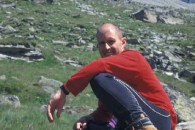

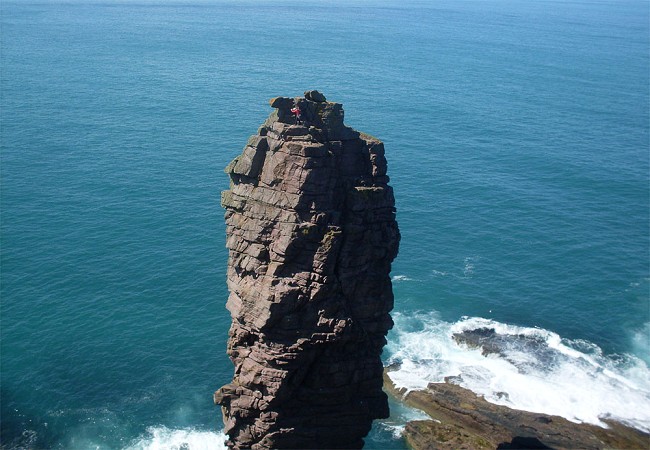
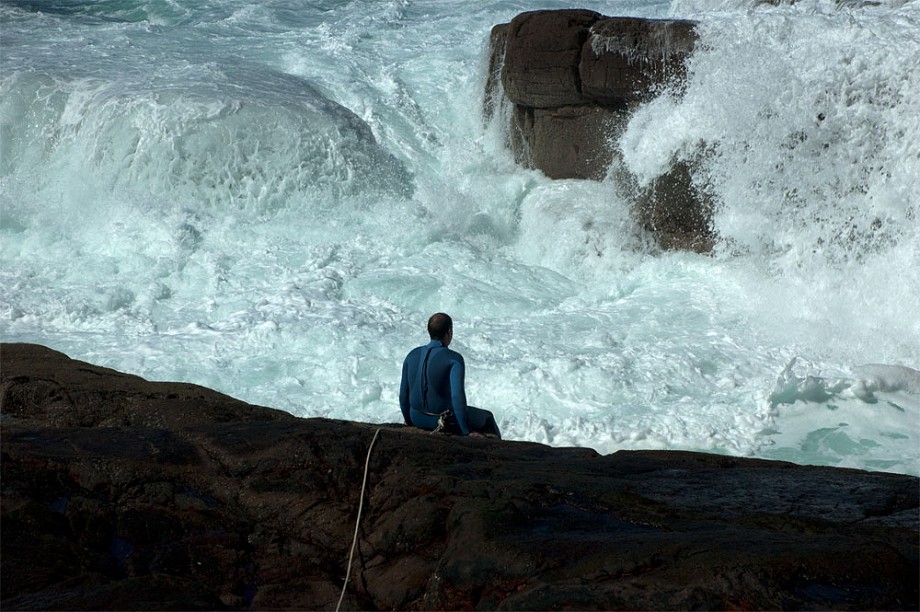
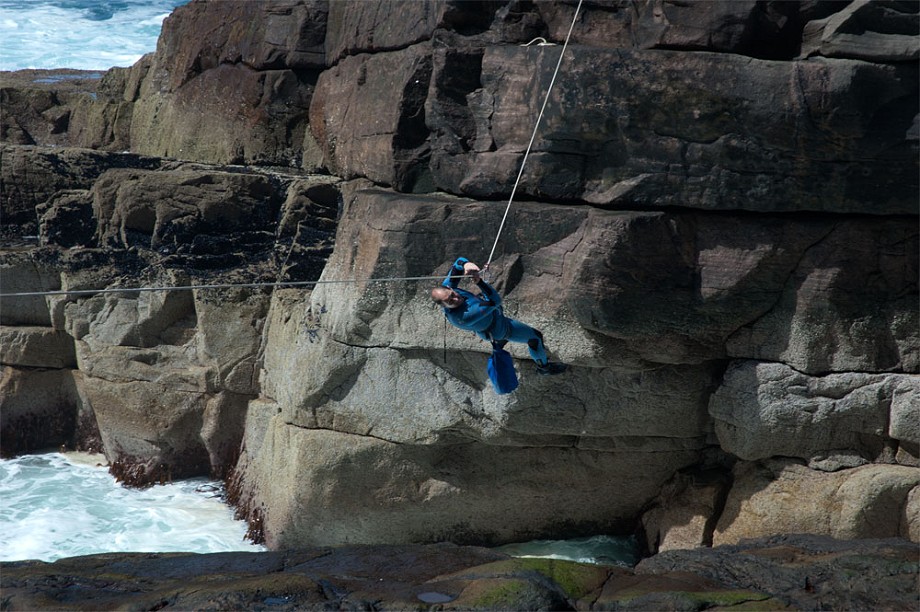
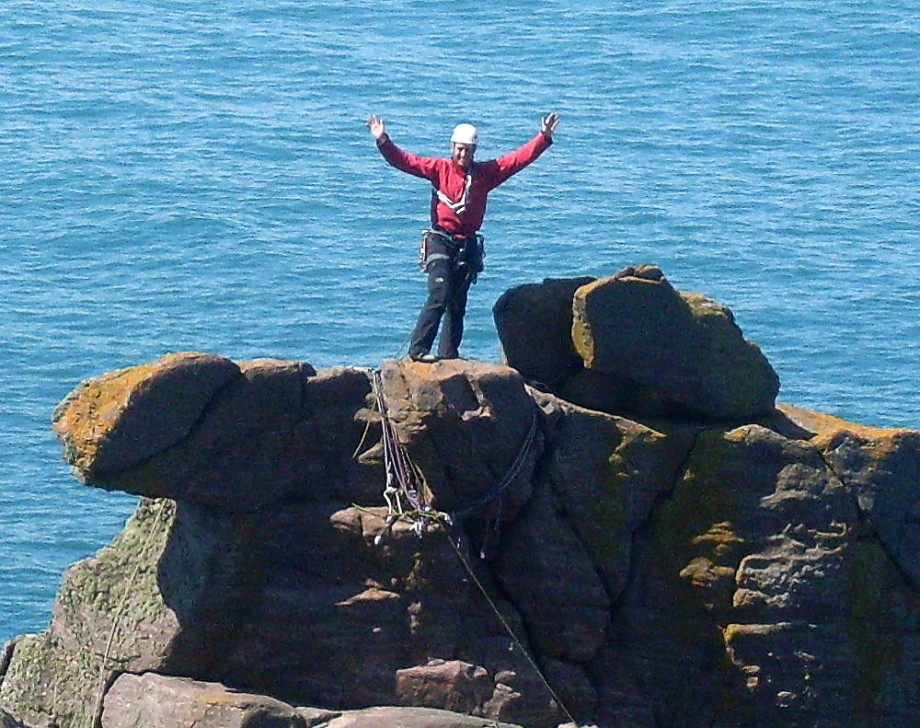


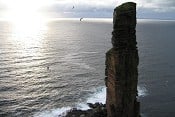
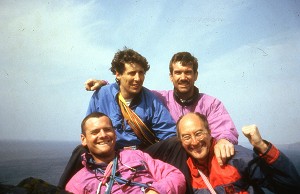
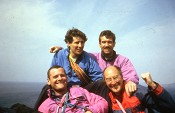








Comments